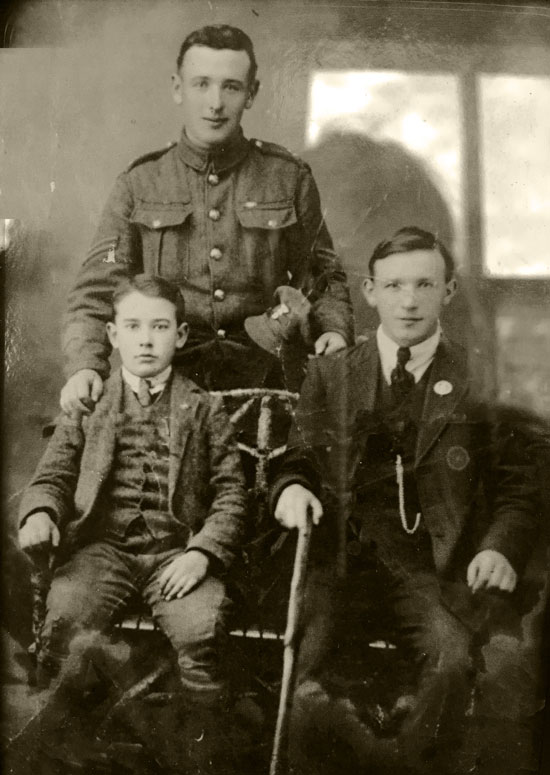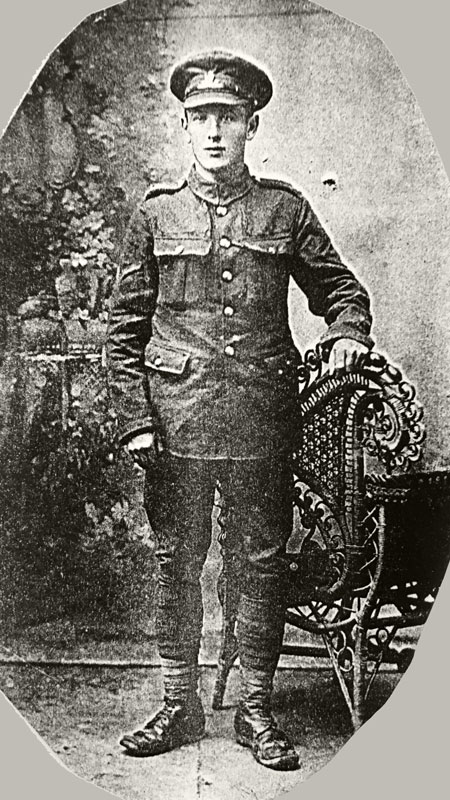Corporal Francis George Kidd

Corporal Kidd in Royal Irish Fusiliers uniform in 1919, with his younger brothers Robert (right) and David
Francis George Kidd was born on 23 October 1894 at Mullaghmore, County Tyrone, the first of seven children of farmer George Kidd and his wife Ellen Maria (nee Jack). He grew up on the family farm at Edenafogry, between Omagh and Fintona.
Kidd enlisted in the North Irish Horse at Fintona on 26 February 1913 (No.805). He embarked for France with C Squadron on 20 August 1914, seeing action in the retreat from Mons and advance to the Aisne. On 17 December 1914 the Belfast News-Letter carried the following article:
WITH THE NORTH IRISH HORSE.
Fintona Man’s Interesting Letter.
In an interesting letter written from the fighting line to his mother, Mrs. Kidd, of Ednafogery, Fintona, Private Frank Kidd, of the North Irish Horse, says that his company has not lost a man since the battle of the Aisne, when they lost their good officer, Lieutenant Combe. “It was our squadron,” he adds, “that covered the retreat of the 5th Division from Mons, and we gave the Uhlans – who were the advance guard of the German army many unpleasant surprises. When we saw them coming we got under cover, and waited until they were within thirty yards of us. We then fired, but they never thought of charging us – it was a race of who could gallop away the fastest. The troops on the march called us ‘Carson’s Horse,’ and we always said we were.” The writer concludes by saying that he has seen the King out there on his visit to the troops. He was on guard on the road when his Majesty passed, and he has also seen the Prince of Wales too.
In April 1915 Captain Ronald Ross joined C Squadron from A Squadron. Kidd was appointed his orderly and continued in that role until September 1917. In that month C Squadron, as part of the 2nd North Irish Horse Regiment, was dismounted and most of its men transferred to the 9th (Service) Battalion, Royal Irish Fusiliers – subsequently named the 9th (North Irish Horse) Battalion. Most, including Kidd, were transferred on 20 September. He was issued a new number – 41270 – and posted to C Company. He was made acting corporal on 31 March 1918 and confirmed in that rank on 19 June.
Kidd was allowed leave from 29 August to 1 October 1918.
On 25 October, as the battalion advanced through Belgium, Kidd was wounded in the right knee by a high explosive shell. He was evacuated to the 2nd Australian General Hospital at Boulogne, where his leg was amputated above the knee. On 22 November he was sent to England where he was treated at Whipps Cross War Hospital, Leytonstone, and then Ormonde House VAD Hospital, Buckhurst Hill. At the end of February 1919 he was allowed home on leave. He was fitted with an artificial limb at the UVF Hospital in Belfast that July.
Corporal Kidd was discharged as no longer physically fit for war service on 31 October 1919, his character marked as "very good". He returned to his family home and for many years kept in touch with his old officer Ronald Ross, who lived at nearby Dunmoyle.

Kidd as a lance corporal in the North Irish Horse
Images of Corporal Kidd kindly provided by his grand-daughter, Catherine Anne Robertson.
